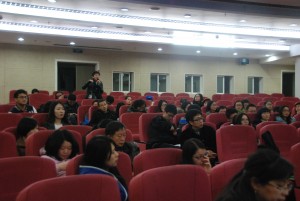British Inter-university China Centre (BICC) Cultural Engagement Postdoctoral Fellowship with the National Trust.
Dr Paul Bevan
Introduction
My first experience working on the history of clocks and the eighteenth-century English “sing-song” trade with China was as part of a music project. “Handel in the Forbidden City”, a collaborative project with Dr Jon Banks of Anglia Ruskin University, looked at the mechanical music found on the clocks exported to China, as part of a broader topic concerning the exchange of ideas and aesthetics between East and West. Much of my research focussed on one particular clock in the collection of the Palace Museum, Beijing, which, unusually for an English-made timepiece, plays the well-known Chinese folk melody Molihua 茉莉花 (Jasmine Blossom). My background in the study of Western eighteenth-century music, as a professional musician for over twenty years, informs my studies of the history and art of the period, as does my specialist knowledge in the areas of Chinese art, literature and music. The BICC project appealed to me for two main reasons. First, it gave me the rare opportunity to combine two areas of expertise: China, and the art and music of eighteenth-century Europe, and secondly, it appealed strongly to my interest in object-based research.
The Project
Initially the remit of the project was to discover the provenance of one clock in the collection of Anglesey Abbey (AA), Cambridgeshire, which had been restored by Matthew Read, Brittany Cox and others at West Dean College. Following an initial inspection of the clock, and other items in the AA collection, it was soon realized that the project would need to expand in scope to include more than just this one clock, as there had clearly been a close relationship between two or more of the clocks in the collection since at least as far back as the turn of the nineteenth century.
Terminology
Two clocks in the collection of Anglesey Abbey have traditionally been known as the “Pagoda Clock” and the “Tower Clock” In fact, the second of these names might best be used to describe both clocks, the name “Pagoda Clock” being something of a misnomer. At the outset of the project I spent some considerable time looking at the latter term and why it should not be used to refer to the example at AA. It is clear that a number of clocks in true “pagoda” form do exist in collections worldwide and the Anglesey Abbey example does not directly relate to these.[1] In the end, for the purposes of this project, it was deemed reasonable to continue referring to the AA clocks by the names by which they had been traditionally known in order to avoid confusion.
The main clocks examined on in this report are:
The Anglesey Abbey Clocks
Pagoda Clock A
Tower Clock A
Singing Bird Clock
The pairs to the AA Clocks
Pagoda Clock B
Tower Clock B
Other Clocks in the Robersons’ Catalogue Eighteenth Century Clocks
Imperial Immortal Mountain Clock
Mirror Clock
Elephant Clock
Simon Harcourt-Smith
The project began with an examination of the available copies of the rare 1933 catalogue of the clocks in the Palace Museum, Beijing, written by the British diplomat Simon Harcourt-Smith, just eight years after the Forbidden City had been established as a museum. The Catalogue of Clocks, Watches, Automata, and Other Miscellaneous Objects of European Workmanship from the XVIII to Early XIX Centuries in the Palace Museum and the Wu Ying Tien, Peiping [Beijing], is the single most important source concerning the history of clocks in the Palace Museum, in the early part of the twentieth century and was important as far as the project is concerned, as it is the earliest document of its type available. The results of these initial investigations, although later found to be not directly relevant to the project, are included in Appendix II. Available information concerning the life of Simon Harcourt-Smith is scant, despite his importance with regard to the history of clocks in China, and the brief introduction found in the appendix may add, in some small way, to the history of Chinese clocks and automata in the early twentieth century.
For the full report written by Dr Paul Bevan;
The Pagoda Clock at Anglesey Abbey


 Following the screenings in UK and China, the film received favourable reviews in national and international media.
Following the screenings in UK and China, the film received favourable reviews in national and international media.
![BBC-British Born Chinese-2177[1]](https://www.bicc.ac.uk/files/2016/03/BBC-British-Born-Chinese-21771-300x225.jpg) In February 2016 ‘British Born Chinese’ was screened as part of the LSE ‘Food for Thought’ Literary festival.
In February 2016 ‘British Born Chinese’ was screened as part of the LSE ‘Food for Thought’ Literary festival.